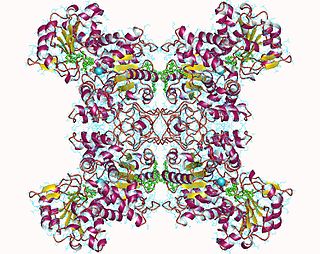| indolelactate dehydrogenase | |||||||||
|---|---|---|---|---|---|---|---|---|---|
| Identifiers | |||||||||
| EC no. | 1.1.1.110 | ||||||||
| CAS no. | 37250-41-2 | ||||||||
| Databases | |||||||||
| IntEnz | IntEnz view | ||||||||
| BRENDA | BRENDA entry | ||||||||
| ExPASy | NiceZyme view | ||||||||
| KEGG | KEGG entry | ||||||||
| MetaCyc | metabolic pathway | ||||||||
| PRIAM | profile | ||||||||
| PDB structures | RCSB PDB PDBe PDBsum | ||||||||
| Gene Ontology | AmiGO / QuickGO | ||||||||
| |||||||||
In enzymology, an indolelactate dehydrogenase (EC 1.1.1.110) is an enzyme that catalyzes the chemical reaction
- (indol-3-yl)lactate + NAD+ (indol-3-yl)pyruvate + NADH + H+
Thus, the two substrates of this enzyme are (indol-3-yl)lactate and NAD+, whereas its 3 products are (indol-3-yl)pyruvate, NADH, and H+.
This enzyme belongs to the family of oxidoreductases, specifically those acting on the CH-OH group of donor with NAD+ or NADP+ as acceptor. The systematic name of this enzyme class is (indol-3-yl)lactate:NAD+ oxidoreductase. This enzyme is also called indolelactate:NAD+ oxidoreductase. This enzyme participates in tryptophan metabolism.





